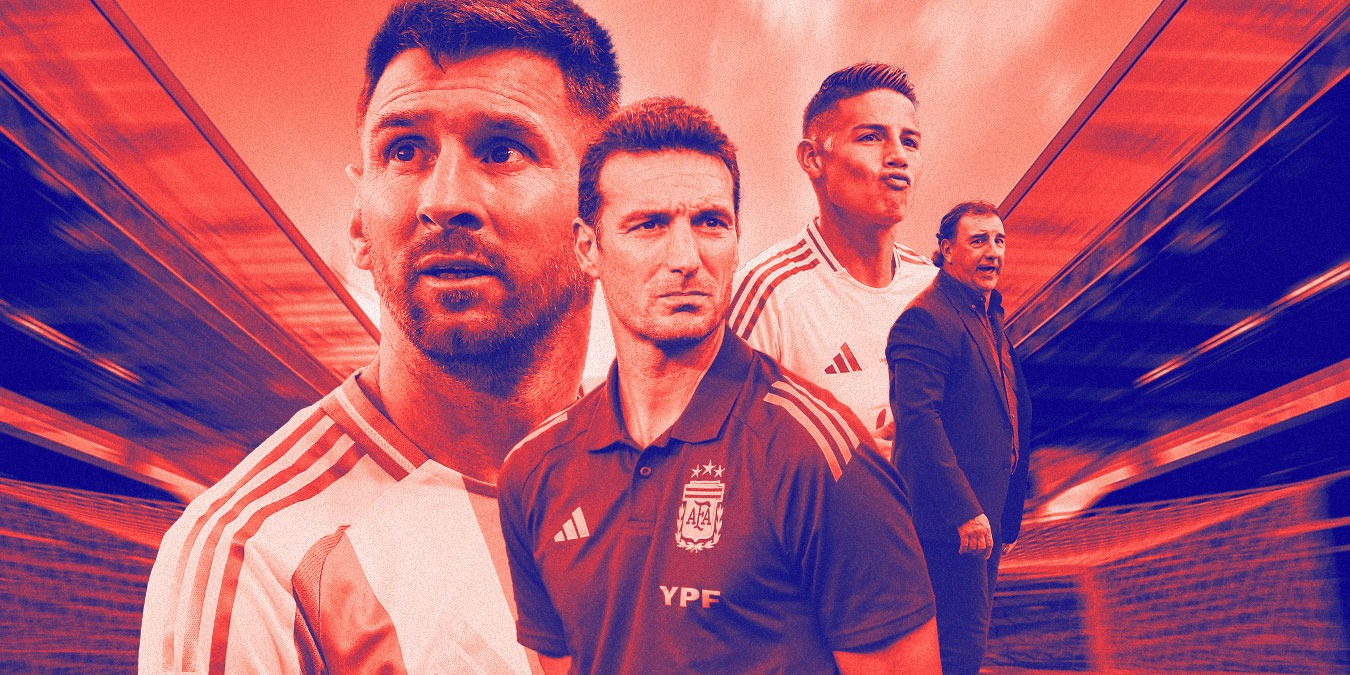On Sunday, Miami will belong to Argentina and Colombia, not either/or. But the outcome of the 2024 Copa America final will inevitably drive one of two unresolvable narratives: Do the accomplishments of Lionel Scaloni’s Argentina place them among the greatest national teams of all time? Or have a seemingly unbeatable Colombia arrived at a paradigm-shifting moment in their football history?
Accustomed to highly competitive football where nothing is forgiven if a title isn’t won, the 2024 Copa America final will offer an exceptional situation: it features two teams that have already accomplished many of their goals. The inherent motivation for a trophy remains intact, but the benefit of not relying on a single match to signal positive development fuels hopes for an exciting final.
Argentina are in their golden era, attempting to become the first South American national team to win three straight major tournaments including a World Cup and first globally since Spain from 2008-12 to encircle a World Cup title with consecutive continental crowns. La Albiceleste could also become the first country to win 16 editions of the Copa America, breaking the deadlock with Uruguay at 15.
Doing so would continue a 41-year pattern of Copa winners. Since 1983, the tournament has followed a particular sequence of champions: One team wins two consecutive tournaments, then another team wins a single tournament, and this pattern repeats. Uruguay won in 1983 and 1987, Brazil won in 1989, Argentina won in 1991 and 1993, and so forth up to Chile winning in 2015 and the 2016 Centenario, Brazil winning in 2019, and Argentina winning in 2021.
Since the 2014 World Cup in Brazil, Argentina have reached at least the semi-finals in all major tournaments except the 2018 World Cup and have been accumulating titles since the 2021 Copa America. First, they took the Copa America from Brazil on their home soil, then they defeated Italy in the Finalissima at Wembley, and finally, they won the 2022 World Cup in Qatar after a match against France that ranks among the greatest finals in major tournament history.
That final meant something to football fans globally, but it meant something more within Argentina. 1986 World Cup winner Jorge Valdano’s famous saying, “Football is the most important of the least important things,” seems understated in Argentina, where the national team’s achievements have been the only common joy for its people in recent years. The pinnacle was when over six million people took to the streets to celebrate the World Cup, a scene comparable only to the country’s most significant milestones, like the Bicentennial of Independence in 2010 or the return of democracy in the early 1980s.
It is a country in which so much revolves around football, with all its positive and negative implications. But given this context, people cannot ask much more from Lionel Scaloni’s team. Unless an embarrassment occurs (such as the 5-0 loss to Colombia that nearly excluded them from the 1994 World Cup), there will be no major complaints if Argentina do not retain the title. There may be no better circumstances for letting the football flow freely.
Critics entering the match may mention their struggle against their first strong opponent, their poor performance against Ecuador, and the fact that their friendlies were against teams like Curaçao or Guatemala, rather than European powerhouses. The most negative voices will claim that the team is “still partying” and that Lionel Messi, now 37 years old at Inter Miami, no longer takes football as seriously as before.
Something similar, though on a far different scale, is happening with Colombia. La Tricolor struggled greatly after the departure of coach José Pekerman in 2018. Under the leadership of Reinaldo Rueda, they could not recover and ended up missing out on the Qatar World Cup. Néstor Lorenzo, Pekerman’s former low-profile assistant, took over without much fanfare but has since built an undefeated streak of 25 matches. Adding the three matches inherited from his predecessor, this constitutes the longest unbeaten run in Colombia’s history, adorned by victories against high-level opponents: a 2-0 win against Germany, a 2-1 win against Brazil and a 1-0 win against Spain. There was the 5-1 thrashing of the United States, and of course the inspired 1-0 win over Uruguay this week to reach the final.
But there’s the obvious distinction that remains: One of these teams has won contemporary major tournaments to complement a history of such achievements. The other has not.
The Colombian Path
Colombia confidently advanced through the group stage beginning with a narrow win against a persistent Paraguay, defeated Costa Rica, who had just frustrated Brazil in a goalless game, and drew with Brazil in a match they probably deserved to win (1.17-0.37 xG). In the quarter-finals, they swiftly neutralised Panama (5-0, with two goals in the first 10 minutes), who had reached the knockouts after defeating the United States and Bolivia.
What followed Colombia’s first-half goal and red card combination in the semi-finals was a monologue by the Uruguayans, who held 73% possession, experimenting with various tactical changes, including bringing on Guillermo Varela for the injured Rodrigo Betancur and later substituting Varela for Luis Suárez. Despite their efforts, they resorted to crossing the ball to the tandem of Darwin Núñez and Suárez while Colombia repeatedly spared Uruguay’s life on the counter-attack, including two missed opportunities by Mateus Uribe of a combined 0.58 xG, both after the 85th minute.
At another point in their history, Colombia, always valued for their technique but criticised for lack of concentration in key moments, would have been eliminated when defending three-quarters of the match with 10 men against a tough opponent. Here, Lorenzo’s team stood tall, held on as best they could with the three most dangerous players on the pitch, and then, after James Rodríguez had given everything, formed a back five.
They reached the final and celebrated with the range of emotions befitting of having won a contentious championship: mocking their rivals, dancing in the locker room, and even James shedding understandable tears. He’d been heavily criticised before the tournament and made it to his first final with a goal and tournament-record six assists (dating to 2011) to become the standout player of the Copa America so far with tournament-highs seven goals involvements and 17 chances created.
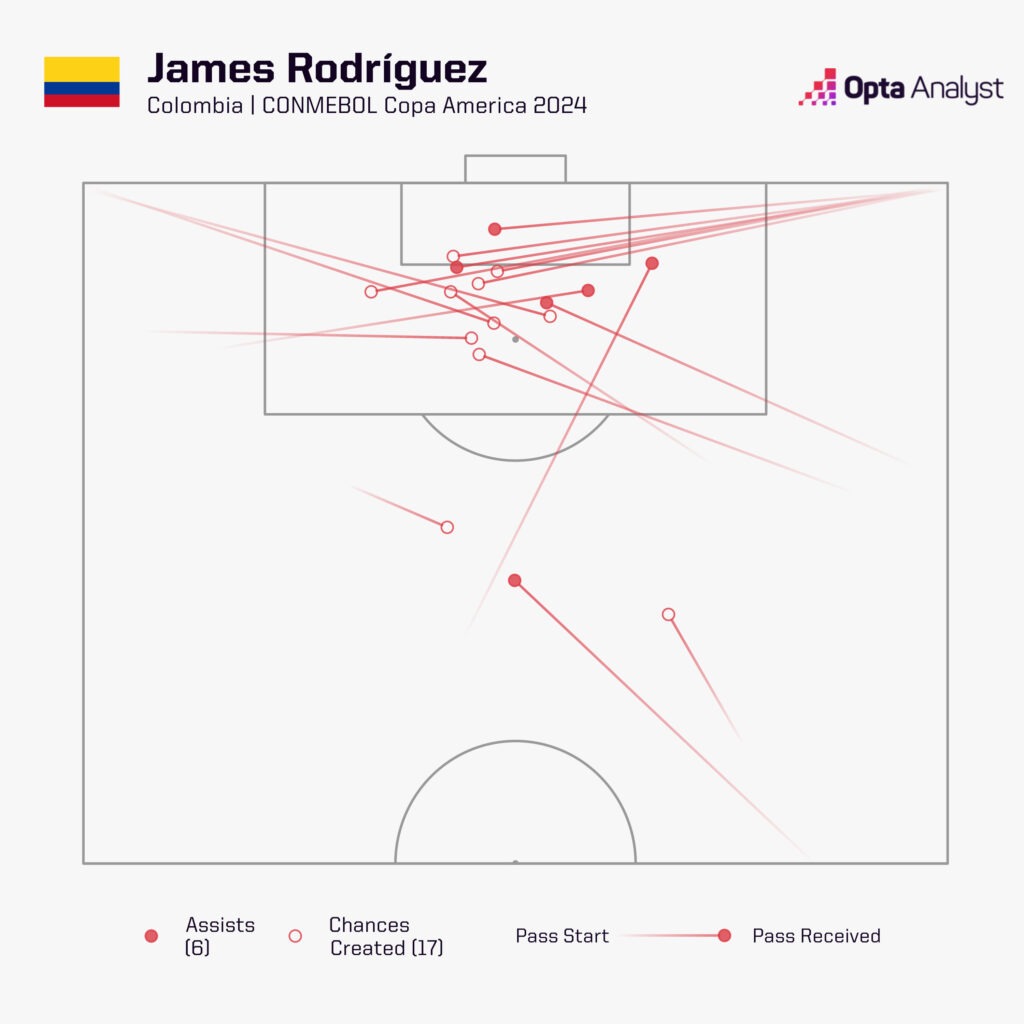
Whatever the outcome of the final, his redemption is irrefutable. And if Colombia do not defeat Argentina in the final, they will still be warmly welcomed by their people, many of whom will see the national team in a major tournament final for the first time. When Colombia won the Copa America at home in 2001, Argentina were absent, and the main contenders were what amounted to a Brazilian B team, Honduras and Mexico. This time, Colombia have not only reached the final through an expanded 16-team field but done so while facing the toughest path.
Colombia bring the tools to challenge Argentina, even in areas where the current World champions typically excel, such as ball possession. Before their match with Uruguay, La Tricolor averaged 57% possession, maintaining control even when ahead, contrary to typical game state trends in football. Argentina’s worst moment came in the second half against Ecuador when they lost control of the ball, complicating a match they could only win by relying on Emiliano ‘Dibu’ Martínez in a penalty shootout.
Beyond the results, it was when each finalist imposed their dynamism on the ball that they gained advantages. Both do so from similar styles of play: they have the longest average passes per sequence in the Copa (4.3 for Argentina, 3.3 for Colombia), with Lorenzo’s team being a bit more direct (1.27 meters per second) than La Albiceleste (0.97 direct speed). The team that manages to impose its game upon the other in the midfield will likely have the advantage in Sunday’s match.
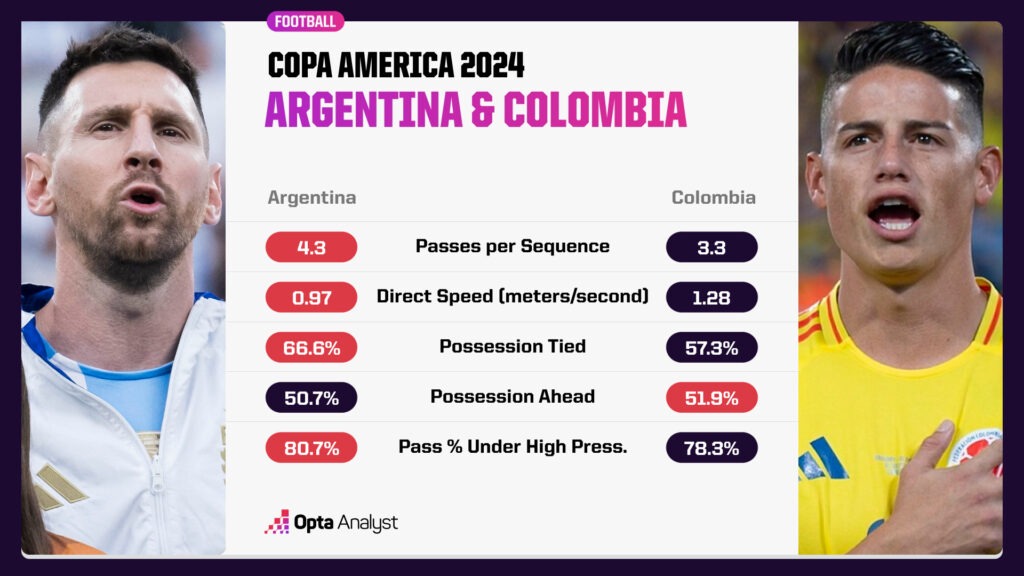
That’s particularly relevant in this matchup because, without possession, Argentina are much more uncomfortable than the 2021 team, which played more on the counter. This might be due to Messi not being in ideal physical condition, losing influence if the team doesn’t control the game. In fact, against Ecuador, he had his least active 90 minutes in a tournament with the national team, with just 32 touches.
Canada’s Alphonso Davies, even without playing at his best, was a headache for the Argentines in the opening match. Colombia’s Daniel Muñoz, who plays for Crystal Palace, had been having a great tournament (two goals, 21 tackles and 18 duels won) and was set to be a key player in the final, but his red card against Uruguay ruled him out. It remains to be seen if Argentina will stick with the 4-3-3 formation that won in Qatar or if, as they have done in recent matches, Ángel Di María will play as a fourth midfielder, reducing exposure on the flanks.
And then, of course, there are the set-pieces that have become a story within the story for Colombia with five goals (excluding penalties) in five matches.
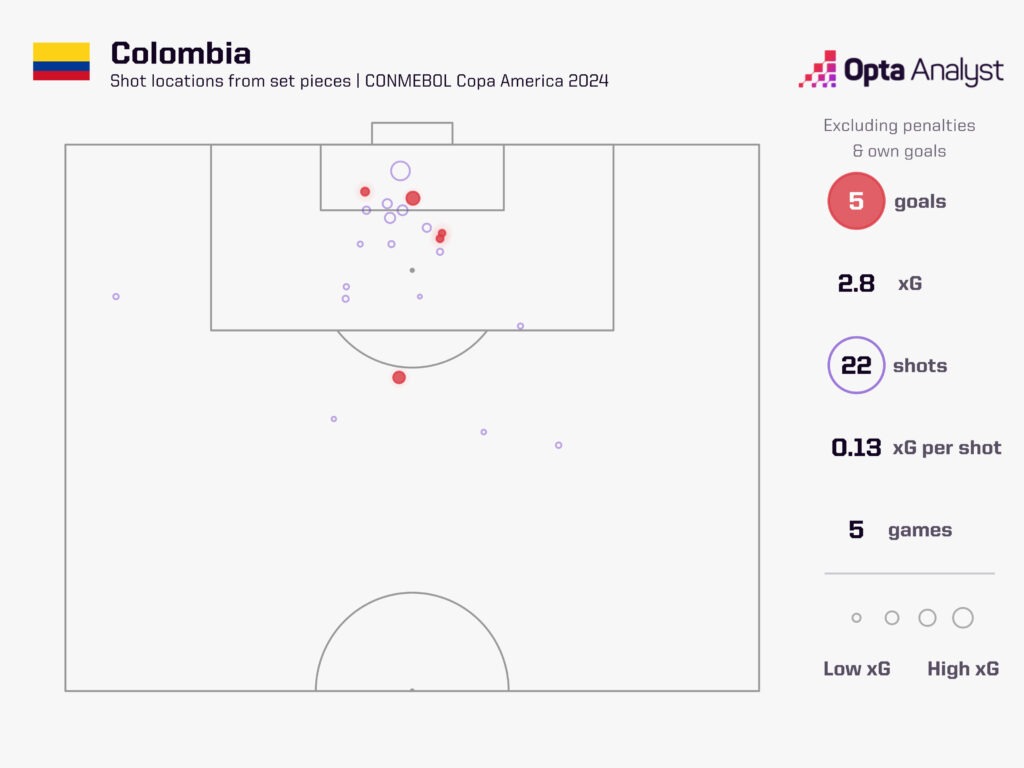
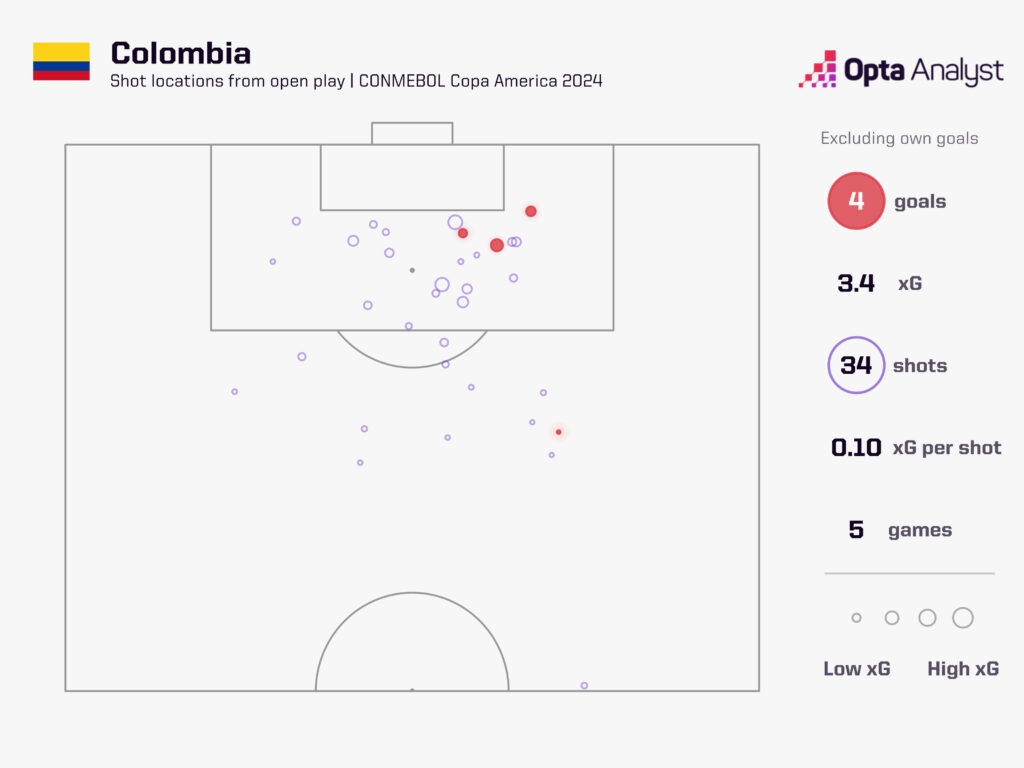
The Calm (and Scare) of the World Champion
Argentina faced few challenges in the group stage, except for a brief period against Canada in the opening match where Messi was surprisingly erratic (6 shots, 0.64 xG, no goals) and the second half against Chile, where the team struggled to convert their chances (1.96 xG, 1 goal). Lautaro Martínez was the standout player in this stage, scoring four goals in just 121 minutes, with only one start (against Peru).
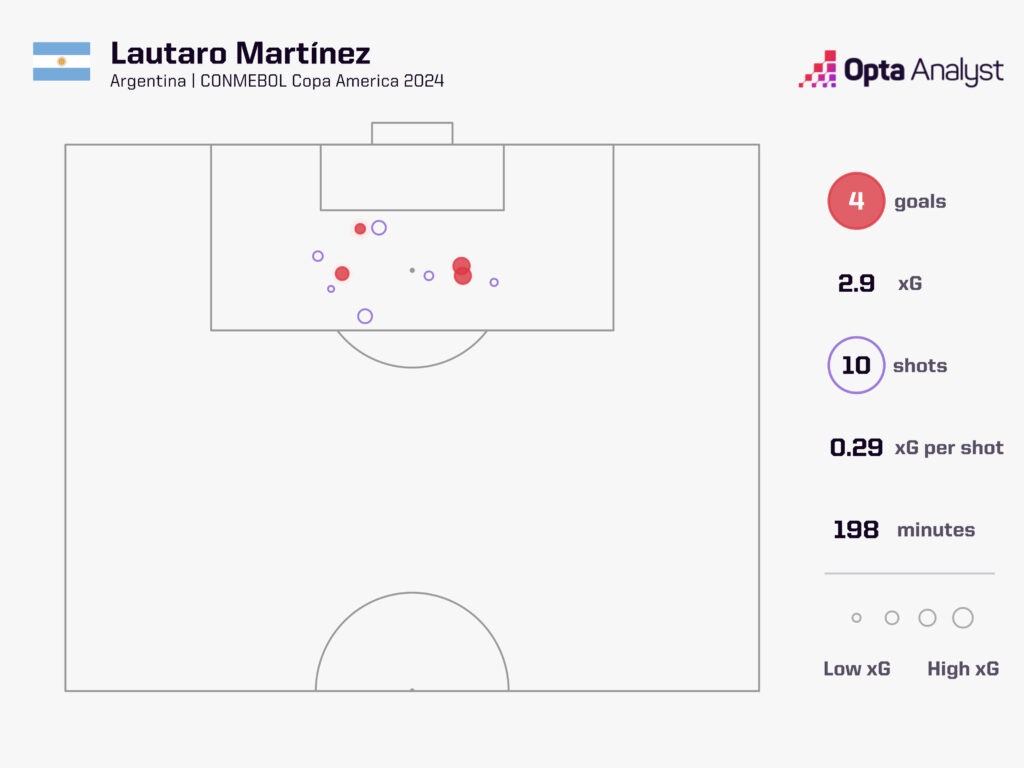
In the quarter-finals, Ecuador, under the guidance of Spanish coach Félix Sánchez (formerly with Qatar), had shown glimpses of a more positional game. However, against Argentina, they resembled the intense style from the Qatar World Cup qualifiers under Gustavo Alfaro. With Enner Valencia leading the attack, things got complicated for La Albiceleste from the start. Lisandro Martínez’s goal from a corner seemed to settle things, and they had a few chances to seal the match in the first half, but Lautaro wasn’t sharp.
The second half was a different story, with La Tri shifting to a Louis Van Gaal-style approach, deploying four forwards and bombarding Argentina with crosses. Ecuador first squandered a chance when Valencia hit the post with his penalty, then equalised late through Kevin Rodríguez after numerous crosses. In the penalty shootout, Emiliano Martínez lived up to his recent reputation, saving two penalties and bringing his tally to eight saves out of 18 attempts in shootouts with the national team.
In the semi-finals against the familiar Canada, Argentina saw a more active Messi (by half-time, he had nearly the same number of touches as in the entire game against Ecuador) and started Julián Álvarez again, who, despite scoring less, contributes more to the functionality of the Scaloneta. Notably, Álvarez is by far the player with the most high-intensity pressures per 90 minutes for Argentina (61.8), significantly more than Lautaro (44.6) and, of course, many more than Messi (22.5).
Another key player in this regard is Rodrigo De Paul, who increasingly earns the ire of his opponents with each game but also contributes more to the team, being the second-highest presser (55.5) and the leader in line-breaking passes (11.2), especially those breaking the midfield and attacking lines, like the one that allowed Julián Álvarez to open the scoring against Canada.
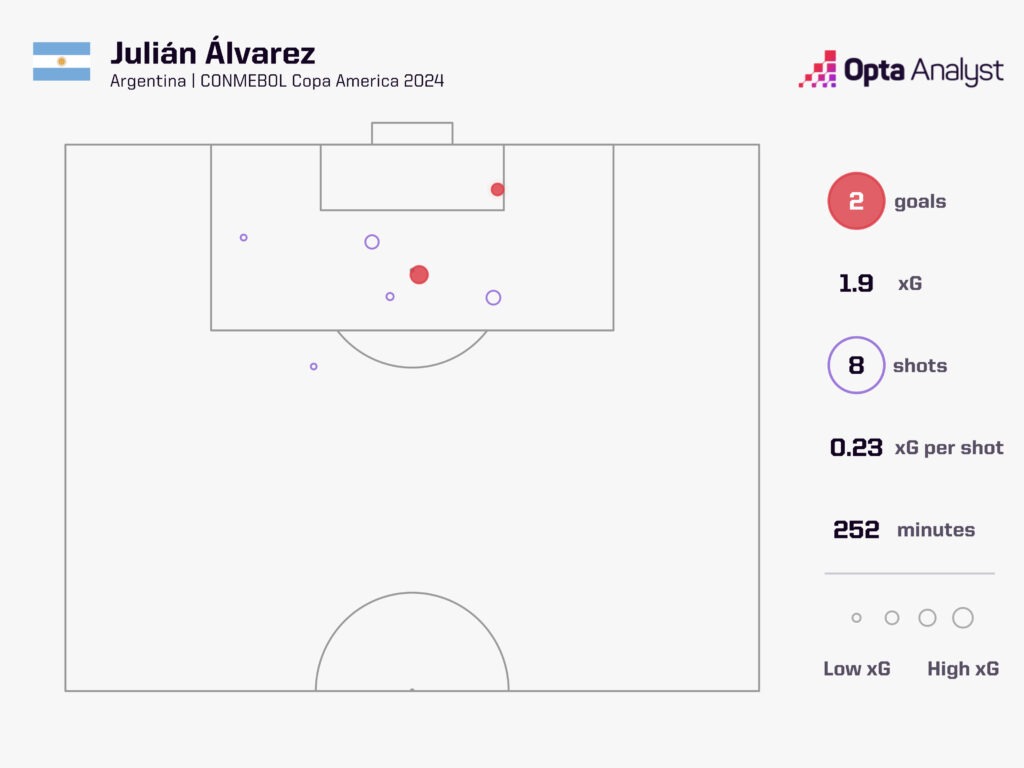
De Paul is the only survivor of the original Scaloneta midfield, which included Roma’s Leandro Paredes and former Rosario Central’s Giovani Lo Celso. They were replaced more due to circumstances (injuries, suspensions) than performance during the World Cup, with the emergence of Alexis Mac Allister and Enzo Fernández. In this Copa America, all have played, with Liverpool’s number 10 showing the most consistent performance and De Paul the more unpredictable. Of all the alternatives Scaloni has tried, the most effective midfield seems to be the one that closed the World Cup in Qatar, with Fernández as the pivot and Mac Allister and De Paul as interiors.
And then there’s Di María, playing his final major tournament with the national team, who often joins this midfield depending on the state of the match. Much has been said and written about the former Real Madrid player, so here’s something different about the 36-year-old who still shows incisive flashes: In this Copa, he leads all players in possession value per 90 minutes (0.42). Whether using new or classic metrics, Di María always stands out. That’s not an easy accomplishment through a career running in parallel with Messi.
They were there together in 2014 in defeat to Germany and through the uncertainty around Scaloni following their 2019 Copa America semi-final exit. They were there together to finally celebrate in 2021 and 2022.
Three years on from an intense but often unattractive final between Argentina and Brazil in which pressure bubbled over, this year’s Copa America final feels likely to deliver a thrilling showdown, befitting of the tournament’s long-tail history and expectations. It often stands in contrast to the European Championship. The individual brilliance of the players, the tactical strategies of the coaches, the vibrant atmosphere from the large contingent of Argentine and Colombian fans in Miami, and the freedom of playing without the gravity of unmet objectives may make this final unmissable.
Enjoy this? Subscribe to our football newsletter to receive exclusive weekly content. You should also follow our social accounts over on X, Instagram, TikTok and Facebook.
